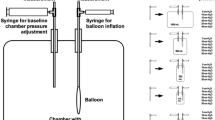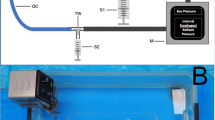Abstract
The mechanical properties of the esophagus are important for its function because the esophagus is subjected to changes in wall stress and strains caused by the passage of boli and the action of peristalsis. Electrodes for impedance planimetry and an ultrasound transducer were placed on the probe inside a fluid-filled bag and used to study the circumferential stress and strain relation of the porcine esophagus in vitro. Impedance planimetry was used to determine the luminal cross-sectional area (CSA) and high-frequency ultrasound was used to determine the esophageal wall thickness during bag distension. Circumferential stress and strain were computed from steady-state values of pressure, CSA, and wall thickness. The incremental elastic modulus was obtained from the slope of the stress-strain curve and was plotted as a function of strain. The steady state pressure-CSA relation was nonlinear. At the lowest and highest luminal pressure load of 1 and 5 kPa, the steady state CSA was 159±20 and 338±25 mm2, respectively. In the same pressure range, the wall thickness decreased from 1.93±0.08 to 1.44±0.08 mm. The slope of the stress-strain curve was 2.58±0.35 kPa. The circumferential stress and the incremental elastic modulus as function of the strain were exponential, that is, the tissue was soft at physiologic pressures and stiffer in the supraphysiologic pressure range. These biomechanical properties of the esophageal wall seem to prevent overstretch of the esophageal wall when luminal loading becomes supraphysiologic.





Similar content being viewed by others
References
Zhou J, Fung YC (1997) The degree of nonlinearity and anisotropy of blood vessel elasticity. Proc Natl Acad Sci USA 94:14255–14260
Graversen PH, Bagi P, Tofft HP, Colstrup H, Kristensen JK (1996) Pressure-to-cross-sectional area relationships in the proximal urethra of men with bladder outlet obstruction. J Urol 155:267–270
Lose G, Colstrup H (1990) Mechanical properties of the urethra in healthy and stress incontinent females: Dynamic measurements in the resting urethra. J Urol 144:1258–1262
Brasseur JG (1993) Mechanical studies of the esophageal function. Dysphagia 8:384–386
Siegle ML, Ehrlein HJ (1989) Effects of various agents on ileal postprandial motor patterns and transit of chyme in dogs. Am J Physiol 257:G698–G703
Siegle ML, Ehrlein HJ (1989) Neurotensin changes the motor pattern in canine ileum from propulsive to segmenting. Dig Dis Sci 34:1521–1527
Gregersen H, Giversen IM, Rasmussen LM, Tottrup A (1992) Biomechanical wall properties and collagen content in the partially obstructed opossum esophagus. Gastroenterology 103:1547–1551
Yang J, Zhao J, Zeng Y, Gregersen H (2004) Biomechanical properties of the rat oesophagus in experimental type-1 diabetes. Neurogastroenterol Motil 16:195–203
Christensen J, Freeman BW, Miller JK (1973) Some physiological characteristics of the esophagogastric junction in the opossum. Gastroenterology 64:1119–1125
Wareham AC, Whitmore I (1982) A comparison of the mechanical properties of oesophageal striated muscle with skeletal muscles of the guinea pig. Pflugers Arch 395:312–317
Fung YC (1981) Biomechanics. Mechanical properties of living tissues. Springer-Verlag, New York, 1981
Juhl CO, Vinter-Jensen L, Djurhuus JC, Gregersen H, Dajani EZ (1994) Biomechanical properties of the oesophagus damaged by endoscopic sclerotherapy. An impedance planimetric study in minipigs. Scand J Gastroenterol 29:867–873
Gregersen H, Stodkilde-Jorgensen H, Djurhuus JC, Mortensen SO (1988) The four-electrode impedance technique: a method for investigation of compliance in luminal organs. Clin Phys Physiol Meas 9(Suppl A):61–64
Gregersen H, Djurhuus JC (1991) Impedance planimetry: A new approach to biomechanical intestinal wall properties. Dig Dis 9:332–340
Gregersen H, Andersen MB (1991) Impedance measuring system for quantification of cross-sectional area in the gastrointestinal tract. Med Biol Eng Comput. 29:108–110
Gregersen H, Orvar K, Christensen J (1992) Biomechanical properties of duodenal wall and duodenal tone during phase I and phase II of the MMC. Am J Physiol 263:G795–G801
Gregersen H, Jorgensen CS, Dall FH, Jensen SL (1992) Characteristics of spontaneous and evoked motility in the isolated perfused porcine duodenum. J Appl Physiol 73:9–19
Gregersen H, Vinter-Jensen L, Juhl CO, Dajani EZ (1996) Impedance planimetric characterization of the distal oesophagus in the Goettingen minipig. J Biomech 29:63–68
Jørgensen CS, Dall FH, Jensen SL, Gregersen H (1995) A new combined high-frequency ultrasound-impedance planimetry measuring system for the quantification of organ wall biomechanics in vivo. J Biomech 28:863–867
Mittal RK (2003) Measuring esophageal distention by high-frequency intraluminal ultrasound probe. Am J Med 115(Suppl 3A):130S–136S
Mittal RK, Liu J, Puckett JL, Bhalla V, Bhargava V, Tipnis N, Kassab G (2005) Sensory and motor function of the esophagus: lessons from ultrasound imaging. Gastroenterology 128:487–497
Nicosia MA, Brasseur JG, Liu JB, Miller LS (2001) Local longitudinal muscle shortening of the human esophagus from high-frequency ultrasonography. Am J Physiol 281:G1022–G1033
Pehlivanov N, Liu J, Kassab GS, Puckett JL, Mittal RK (2001) Relationship between esophageal muscle thickness and intraluminal pressure: An ultrasonographic study. Am J Physiol 280:G1093–G1098
Takeda T, Kassab G, Liu J, Puckett JL, Mittal RR, Mittal RK (2002) A novel ultrasound technique to study the biomechanics of the human esophagus in vivo. Am J Physiol 282:G785–G793
Takeda T, Kassab G, Liu J, Nabae T, Mittal RK (2003) Effect of atropine on the biomechanical properties of the oesophageal wall in humans. J Physiol 547:621–628
Takeda T, Nabae T, Kassab G, Liu J, Mittal RK (2004) Oesophageal wall stretch: The stimulus for distension induced oesophageal sensation. Neurogastroenterol Motil 16:721–728
Drewes AM, Pedersen J, Liu W, Arendt-Nielsen L, Gregersen H (2003) Controlled mechanical distension of the human oesophagus: sensory and biomechanical findings. Scand J Gastroenterol 38:27–35
Drewes AM, Reddy H, Staahl C, Pedersen J, Funch-Jensen P, Arendt-Nielsen L, Gregersen H (2005) Sensory-motor responses to mechanical stimulation of the esophagus after sensitization with acid. World J Gastroenterol 11:4367–4374
Gao C, Arendt-Nielsen L, Liu W, Petersen P, Drewes AM, Gregersen H (2003) Sensory and biomechanical responses to ramp-controlled distension of the human duodenum. Am J Physiol 284:G461–G471
Gregersen H (2002) Biomechanics of the gastrointestinal tract. Springer-Verlag, London
Gregersen H, Jensen LS, Djurhuus JC (1988) Changes in oesophageal wall biomechanics after portal vein banding and variceal sclerotherapy measured by a new technique. An experimental study in rabbits. Gut 29:1699–1704
Gregersen H, Knudsen L, Eika B, Nerstrom LS, Rasmussen L, Jensen LS (1991) A time-dependent study of passive esophageal wall properties and collagen content in rabbits with esophageal varices. Dig Dis Sci. 36:1050–1056
Conklin JGR (1989) Gastrointestinal smooth muscle. In: Sleisinger MH, (ed) Gastrointestinal disease. WB Saunders, Philadelphia
Fan Y, Zhao J, Liao D, Gregersen H (2005) The effect of digestion of collagen and elastin on histomorphometry and the zero-stress state in rat esophagus. Dig Dis Sci 50:1497–1505
Gao C, Petersen P, Liu W, Arendt-Nielsen L, Drewes AM, Gregersen H (2002) Sensory-motor responses to volume-controlled duodenal distension. Neurogastroenterol Motil 14:365–374
Gregersen H, Lu X, Zhao J (2004) Physiological growth is associated with esophageal morphometric and biomechanical changes in rats. Neurogastroenterol Motil 16:403–412
Petersen JA, Duch BU, Gregersen H (1999) Luminal cross-sectional area and wall distensibility in the isolated porcine oesophagus. Int J Surg Investig 1:23–28
Zhao J, Yang J, Vinter-Jensen L, Zhuang F, Gregersen H (2003) Biomechanical properties of esophagus during systemic treatment with epidermal growth factor in rats. Ann Biomed Eng 31:700–709
Park W, Vaezi MF (2005) Etiology and pathogenesis of achalasia: the current understanding. Am J Gastroenterol 100:1404–1414
Froehlich F, Juillerat P, Mottet C, Felley C, Vader JP, Burnand B, Gonvers JJ, Michetti P (2005) Obstructive fibrostenotic Crohn's disease. Digestion 71:29–30
Author information
Authors and Affiliations
Corresponding author
Rights and permissions
About this article
Cite this article
Zhao, J., Jørgensen, C.S., Liao, D. et al. Dimensions and Circumferential Stress-Strain Relation in the Porcine Esophagus in Vitro Determined by Combined Impedance Planimetry and High-Frequency Ultrasound. Dig Dis Sci 52, 1338–1344 (2007). https://doi.org/10.1007/s10620-006-9238-6
Received:
Accepted:
Published:
Issue Date:
DOI: https://doi.org/10.1007/s10620-006-9238-6




